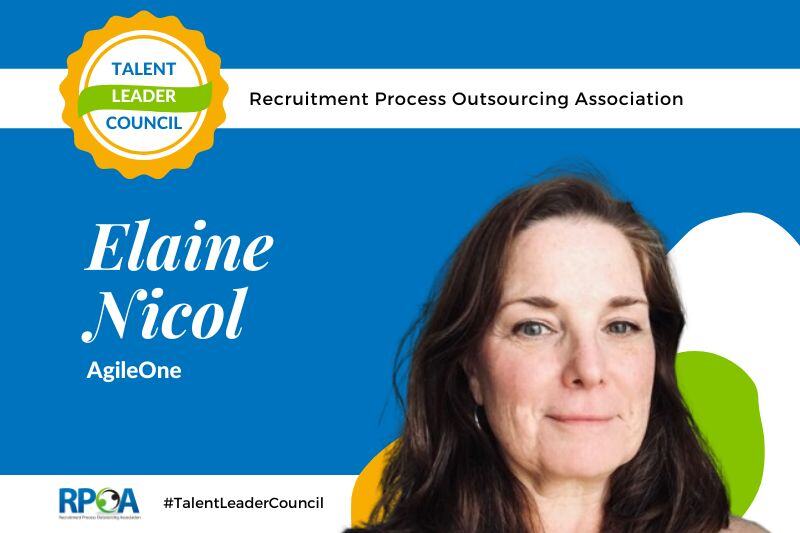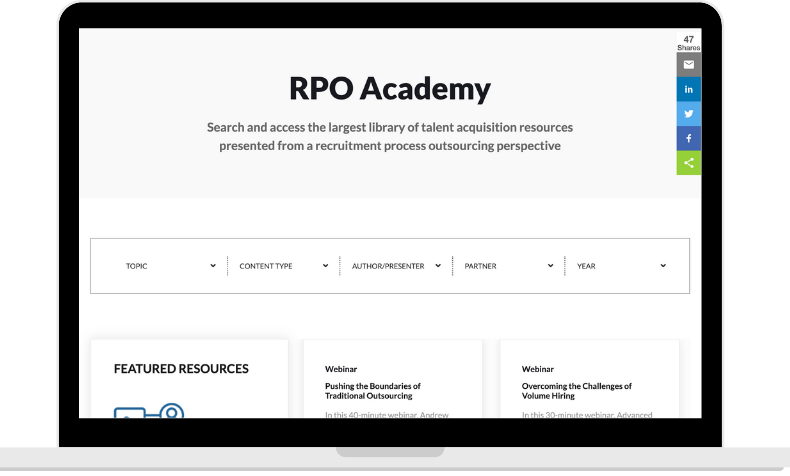
In today’s volatile economy, Talent Acquisition leaders navigate unprecedented challenges. Economic fluctuations bring unpredictable hiring demands while internal recruitment teams struggle to uphold quality amid limited resources. Companies face the dilemma of overhiring recruiters for temporary needs or overwhelming existing staff. On-demand recruiting, or Project RPO, emerges as a strategic solution, showing a 7 percent growth from 2023 to 2024, according to the 2025 RPO Trends Report. Lighthouse Research & Advisory's 2024 study reveals that fewer than half of companies accurately predicted hiring volume, underscoring the necessity of this “relief valve” approach.
With defined scope and duration, on-demand recruiting allows organizations to scale recruitment capabilities precisely when needed. This model excels during facility expansions, product launches, seasonal surges, and geographical relocations, situations where traditional recruitment struggles to adapt.
In this article, we share insights based on recent interviews with three RPOA members: Chip Holmes, who serves as an Internal Consultant at Randall Reilly and is recognized as a global leader in Recruitment Process Outsourcing (RPO); Jamie Minier, the President at NXTThing RPO; and Heather Siler, the Vice President of Talent Solutions at Hire Velocity.
Their combined expertise reveals how forward-thinking talent acquisition leaders use on-demand recruiting to transform hiring challenges into strategic opportunities.
Q: Why do companies face a scalability crisis in talent acquisition?
Economic uncertainty has created unprecedented scalability challenges for talent acquisition teams. Internal recruitment functions struggle to adapt to rapidly changing hiring demands that fluctuate with market conditions, often without warning.
Holmes: The primary driver behind this scalability crisis is the economic uncertainty we've experienced in recent years. With events like COVID and its aftermath, predicting business demand has become virtually impossible. Companies can no longer accurately forecast their talent needs six months ahead, let alone develop stable long-term recruitment plans.
This unpredictability forces talent leaders into a difficult position: either maintain a large recruitment team underutilized during slow periods or operate with a minimal team that becomes overwhelmed during sudden hiring surges. Both approaches lead to inefficiency – wasting resources during downturns or missing critical talent acquisition targets during growth periods.
Siler: Healthcare organizations exemplify this dilemma perfectly. The sector experienced dramatic surges during COVID-19, followed by post-pandemic adjustments, and now faces ongoing fluctuations. Even when demand for healthcare services remains relatively constant, the talent requirements shift dramatically based on geographic expansion, new facility openings, or specialized program launches that require different skill sets on short notice.
Q: How does on-demand recruiting function as a relief valve solution?
On-demand recruiting provides the flexibility companies need to address unpredictable hiring demands without permanent infrastructure changes. It serves as a relief valve by temporarily expanding recruitment capabilities precisely when needed.
Holmes: Project-based RPO becomes the relief valve because you bring in people who excel at hiring and ramping up and down quickly. RPO providers typically bring technology to support the process. They understand surges, they understand how to ramp, and they understand how to integrate themselves into the culture of the company. Once you engage them, they can walk you through the project, and when it's done, you disengage until you need them. You haven't disrupted your team or put too much on their plate.
This model represents a special vendor-customer engagement with a defined scope and duration. This differs from Enterprise RPO, which spans all recruiting functions for all roles, business entities, and locations companywide. In 2024, Enterprise RPO comprised 37 percent of engagement types in the RPO market, while project-based approaches continue gaining traction.
Minier: The approach offers organizations a "try-before-you-buy" opportunity. Companies reluctant to outsource their entire recruitment function can test RPO services in a controlled environment. This cautious approach helps organizations experiencing reduced internal teams still meet periods of high hiring demand.
The surge in on-demand recruiting relates directly to economic changes, forcing organizations to shrink internal recruiting teams. Smaller teams must find alternative solutions to handle workloads that exceed their capacity. On-demand recruiting fills these gaps while allowing organizations to maintain control over their core recruitment strategy and employer brand.
Use flexible recruitment solutions to navigate market volatility. Visit the iCoCo Marketplace now to connect with specialized providers who scale resources when needed.
Q: What are some real-world examples that illustrate how on-demand recruiting is addressing scalability challenges?
Organizations across industries have successfully implemented on-demand recruiting to address specific hiring challenges that would overwhelm internal resources. These case studies demonstrate the model's versatility and effectiveness.
Holmes: A great example occurs during new drug launches by pharmaceutical companies. They often use this approach to hire salespeople for that launch. The RPO firm ramps up quickly, makes the hires, and then steps away until needed again.
I can also think of a large engineering company that moved from the Northwest to the Southwest. Rather than changing their recruiting structure, they brought in an RPO specifically to address the relocation needs, effectively ramping up staffing at the new location.
A large healthcare company in the Northeast purchased a hospital chain and needed to hire 180 nurses but did not have the recruitment personnel to hire even 18 nurses. They brought in an RPO to handle this volume.
Retail companies frequently need to scale up hiring during peak seasons but don't need a full-time recruiting team year-round. On-demand recruiting handles these temporary hiring surges.
Siler: A behavioral therapy organization implementing global expansion partnered with Hire Velocity for targeted recruitment. The project required team development across multiple European countries with specific hiring metrics per location within established timeframes. The engagement addressed immediate scaling requirements while establishing a foundation for a steady-state recruitment transition. This approach eliminated requirements for additional internal recruiters or resource reallocation for temporary volume increases.
Q: What are the top three advantages that make on-demand recruiting effective for scaling?
On-demand recruiting delivers three fundamental advantages that enable organizations to scale effectively: burst capacity to handle volume spikes, specialized expertise for targeted hiring needs, and technology enhancements that accelerate outcomes.
1) Burst Capacity
Minier: Experienced RPO providers maintain "burst capacity" (23-25% at NXTThing RPO), allowing immediate project scaling. Clients benefit from expertise, speed, and results without fixed overhead costs or extended commitments.
This approach protects organizations from overreactions during talent fluctuations - neither overwhelming existing teams nor overhiring for temporary needs.
2) Specialized Expertise
Minier: On-demand recruiting spans all vertical markets rather than concentrating in specific industries. The determining factor involves organizational state and objectives. Some implementations focus on specific functions like sourcing or screening rather than end-to-end recruitment, creating further flexibility.
Siler: On-demand recruiting partners function as extensions of client organizations rather than external providers. They represent employer brands throughout market interactions and approach each search individually rather than leveraging existing candidate databases.
3) Technology Enhancement
Holmes: RPO companies bring AI and automation to help with sourcing, screening and diversity concerns. Analytics are another crucial component, allowing teams to process information and make rapid decisions. Technology and AI provide valuable predictive capabilities that accelerate the entire process.
Siler: Time-sensitive projects leverage AI capabilities to reduce administrative requirements and optimize recruiter focus on high-value activities. While AI enhances initial sourcing and screening, comprehensive candidate assessment requires human judgment. In-person interaction and cultural alignment assessment demand a human perspective.
Transform your recruitment capabilities with AI-enhanced on-demand solutions. Review the 2025 RPO Trends Report for data-driven insights on technology's impact.
Q: How is on-demand recruiting evolving strategically?
The on-demand recruiting model continues to mature from a purely transactional service into a strategic component of talent acquisition strategy. This growth reflects broader shifts in how organizations view recruitment outsourcing.
Holmes: Project RPO will evolve significantly, becoming more strategic and analytical. Companies now want technology, data analysis, and strategic decision-making beyond just hiring people quickly. They're asking about workforce planning and technology stack integration.
Some RPO providers have technology that employers can use on the back end, allowing them to manage recruitment internally rather than relying entirely on the RPO provider for ongoing services. On-demand recruiting will shift from a highly transactional service to a strategic component of the overall hiring function.
Minier: On-demand recruiting will continue growing beyond industry average rates (4-5%). Recent months show a resurgence in both frontline and professional spaces. First-generation RPO users drive much of this adoption, testing the approach before expanding. Many project relationships evolve into broader service engagements, including enterprise RPO and additional recruitment services.
Q: What are the success factors of a Project RPO implementation?
Successful implementation requires thoughtful planning and stakeholder alignment. Organizations should assess their baseline needs, establish clear objectives, and develop appropriate performance metrics.
Minier: Organizations should determine their baseline recruiting requirements - how many recruiters they need for normalized operations. On-demand recruiting makes sense when additional demands exceed this baseline through new initiatives, site launches, or seasonal requirements.
Companies must decide whether these additional needs warrant full-time staff additions or if they need assistance with specific parts of the recruitment process. On-demand recruiting provides temporary capacity that scales up and down with organizational needs.
Siler: Effective change management and communication drive successful implementations. Leadership support ensures organization-wide adoption throughout the implementation and engagement phases. Executive engagement guarantees program adoption and measurable outcomes.
Data represents a critical component because project implementations require clear proof of effectiveness. Organizations testing on-demand solutions need measurable outcomes showing the approach works. Effective implementation requires establishing key metrics upfront, tracking progress consistently, and measuring final results.
Visit the RPO Academy for informative webinars on strategic implementation of flexible RPO recruiting solutions.
Q: How does on-demand recruiting create a competitive advantage?
Organizations using on-demand recruiting adapt faster to market conditions, execute strategic initiatives without recruitment bottlenecks, and maintain consistent candidate quality regardless of volume fluctuations. This elasticity transforms talent acquisition from a potential constraint into a strategic enabler of business growth.
Minier: ROI metrics vary based on client priorities - quality, speed, or turnover reduction. Successful implementations often deliver substantial improvements, with some clients experiencing a 20% turnover reduction. The key involves determining which metrics matter most to each client and building measurement approaches aligned with those priorities.
Siler: Project RPO delivers enhanced visibility into costs, timelines, and deliverables without disrupting existing talent functions. Dedicated project teams reduce pressure on internal recruitment resources while focusing on operational recruitment throughout the project.
Companies leveraging flexible talent solutions position themselves to capitalize on market opportunities faster than competitors constrained by rigid recruitment infrastructure. When business conditions shift—whether through expansion, acquisition, or market contraction—organizations with on-demand recruiting capabilities respond with appropriate talent resources that precisely match current needs.
Gain competitive advantage through strategic talent scalability. Connect with RPO experts through the iCoCo Marketplace who employ flexible on-demand solutions.
Check our TA Leader Council on the RPO Voice blog for more insights from Talent Leader Council contributors.
This article integrates insights from RPOA Talent Leader Council expert interviews with industry data from the 2025 RPO Trends Report and findings from the 2024 Lighthouse Research & Advisory Talent Acquisition Trends study of 1,234 global employers and 1,000 candidates.














